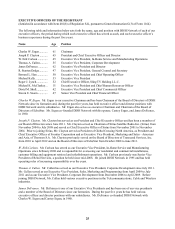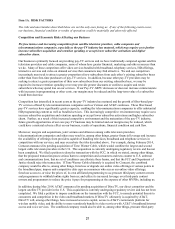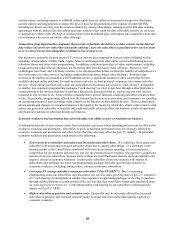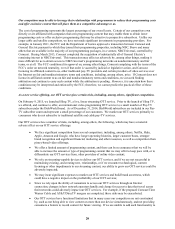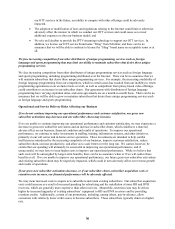Dish Network 2014 Annual Report Download - page 45
Download and view the complete annual report
Please find page 45 of the 2014 Dish Network annual report below. You can navigate through the pages in the report by either clicking on the pages listed below, or by using the keyword search tool below to find specific information within the annual report.
35
35
New technologies could also create new competitors for us. For instance, we face increasing consumer demand for
the delivery of digital video services via the Internet, including providing what we refer to as “DISH Anywhere.”
We expect to continue to face increased threats from companies who use the Internet to deliver digital video services
as the speed and quality of broadband and wireless networks continues to improve.
Technological innovation is important to our success and depends, to a significant degree, on the work of technically
skilled employees. We rely on EchoStar to design, develop and manufacture set-top boxes with advanced features
and functionality and to provide the IPTV streaming technology for our OTT services. If EchoStar is unable to
attract and retain appropriately technically skilled employees, our competitive position could be materially and
adversely affected. In addition, delays in the delivery of components or other unforeseen problems associated with
our technology may occur that could materially and adversely affect our ability to generate revenue, offer new
products and services and remain competitive.
We rely on a single vendor or a limited number of vendors to provide certain key products or services to us such
as information technology support, billing systems, and security access devices, and the inability of these key
vendors to meet our needs could have a material adverse effect on our business.
Historically, we have contracted with a single vendor or a limited number of vendors to provide certain key products
or services to us such as information technology support, billing systems, and security access devices. If these
vendors are unable to meet our needs because they fail to perform adequately, are no longer in business, are
experiencing shortages or discontinue a certain product or service we need, our business, financial condition and
results of operations may be adversely affected. While alternative sources for these products and services exist, we
may not be able to develop these alternative sources quickly and cost-effectively, which could materially impair our
ability to timely deliver our products to our subscribers or operate our business. Furthermore, our vendors may
request changes in pricing, payment terms or other contractual obligations between the parties, which could cause us
to make substantial additional investments.
Our primary supplier of new set-top boxes, EchoStar, relies on a few suppliers and in some cases a single
supplier, for many components of our new set-top boxes, and any reduction or interruption in supplies or
significant increase in the price of supplies could have a negative impact on our business.
EchoStar relies on a few suppliers and in some cases a single supplier, for many components of our new set-top
boxes that we provide to subscribers in order to deliver our digital television services. Our ability to meet customer
demand depends, in part, on EchoStar’s ability to obtain timely and adequate delivery of quality materials, parts and
components from suppliers. In the event of an interruption of supply or a significant price increase from these
suppliers, EchoStar may not be able to diversify sources of supply in a timely manner, which could have a negative
impact on our business. Further, due to increased demand for products, many electronic manufacturers are
experiencing shortages for certain components. EchoStar has experienced in the past and may continue to
experience shortages driven by raw material availability, manufacturing capacity, labor shortages, industry
allocations, natural disasters, logistical delays and significant changes in the financial or business conditions of its
suppliers that negatively impact our operations. Any such delays or constraints could have a material adverse effect
on our business, financial condition and results of operations, including, among other things, our gross new
subscriber activations.
Our programming signals are subject to theft, and we are vulnerable to other forms of fraud that could require us
to make significant expenditures to remedy.
Increases in theft of our signal or our competitors’ signals could, in addition to reducing gross new subscriber
activations, also cause subscriber churn to increase. To combat signal theft and improve the security of our
broadcast system, we use microchips embedded in credit card sized access cards, called “smart cards,” or security
chips in our receiver systems to control access to authorized programming content (“Security Access Devices”).
Our signal encryption has been compromised in the past and may be compromised in the future even though we
continue to respond with significant investment in security measures, such as Security Access Device replacement
programs and updates in security software, that are intended to make signal theft more difficult. It has been our
prior experience that security measures may only be effective for short periods of time or not at all and that we


